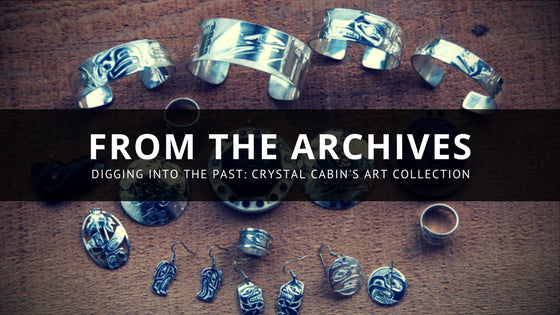Your Cart is Empty
LOCALLY OWNED & OPERATED SINCE 1984
LOCALLY OWNED & OPERATED SINCE 1984
LOCALLY OWNED & OPERATED SINCE 1984

Take a look back into the Crystal Cabin archives! We hope you enjoy as we explore the work of the many Haida carvers and artists who we’ve had the pleasure to know over the years, such as:
Christian White, Gitsxaa (Ron Wilson), Alfie Collinson, Ding Hutchingson, Vernon White, Carmen Goertzen, Ron Russ, Chris Russ, Myles Edgars, Mike Brown, Marcel Russ, Garner Moody, Leon Ridley, Robert Vogstad, Clayton Gladstone, Gregory Williams, Steve Hansen, Norman Bentley, Derek White, George Yeltatzie and many more!
For over 30 years Crystal Cabin has been a hub of Haida jewelry and fine arts, and we want to share our collection with you!
Before we look at Haida art forms we first must understand the purpose behind it and how it has evolved into the modern art world. There is a lot to be considered before you purchase a piece, as it carries much more than the artistic value with it. These pieces are not just a form of art for the Haida, they often depict particular humans or supernatural beings that tell their intricate histories. These detailed designs twist and turn through the ancient worlds that still influence the voice and values of the Haida people today.
Haida people commonly wore their family crests on their bodies in forms of tattoos. These crests were easily distinguishable and served as a means of presenting one’s identity and lineage. Arm and leg cuffs made of metals such as copper, and later on silver and gold, were also common and served the same purpose of identification. This jewelry became even more normalized after contact with European explorers. The traditional tattoos were soon scrutinized by these colonizers, who saw it as shameful to bear traditional crests on one’s body. The jewelry, however, was removable, thus considered more acceptable. There are many photos of First Nations people during this time period wearing long-sleeved shirts and high collars to hide their traditional ink.
Today, tattooing is gaining more traction as it is becoming a form of resistance against colonization and cultural oppression. This also amplifies the pride of wearing one’s crest within the jewelry and other clothing or ceremonial regalia.
Haida Art has gained much attention around the world, and today there are countless collectors and admirers seeking out Haida carvers and purchasing their pieces. Crystal Cabin has been happy to take part in this celebration of Haida fine arts and support the local artists who continue to carry on this ancient art form. Here is a look back at some of our pieces that have been collected over the years.
Above: Silver bracelets depicting Sculpin, Eagle, Hummingbird and Raven crests
Above: Gold bracelets, rings and pendant depicting Wasgo, Eagle, Hummingbird and Killer Whale crests
Argillite is a soft black slate found and carved only by the Haida people in Haida Gwaii. For more information on this unique stone please see our blog titled Argillite: The Stone of Haida Gwaii.
Above: Two different representations of one of the earliest Haida origin stories: Raven and the First Men (Argillite with abalone and ivory inlays)
This story depicts Raven the Trickster, also known as He Whose Voice is Obeyed, who coaxed the first Haida People out of the Clam Shell.
Above: Two representations of Haida Shaman, also known as Medicine Men. These people were highly respected and looked upon for their knowledge of healing physical, mental and spiritual ailments. (Argillite, gold, red argillite and ivory)
Above: Argillite platters depicting crests of Raven, Frog, Dogshark, Human and Killer whales
Above: Different representations of the Bear Mother story. This story depicts a young woman who disrespected the Bear People and was captured by them as punishment. She became a wife to a bear man and gave birth to half bear-half human children. This is an origin story that teaches good morals and respect towards all beings.
Above: Argillite carving depicting a story of Woman Who Was Captured by a Killer whale
The woman’s husband is seen on the back of the killer whale.
Above: Rattles depicting Raven, Human, and Bear Crests (Cedar, abalone inlays, red and black paint)
Rattles are used during ceremonial practices, either for medicinal practices or during a song
Above: Red cedar bentwood box. This represents the traditional form of box making, which for the Haida, included steaming the planks and bending them into place. These boxes have been used for storage, as well as cooking with hot rocks placed inside and filling the box with water.
Above: Small cedar poles depicting Beaver, Bear, and Killerwhale crests. Often times carvers will also scale their house frontal poles into small ones before carving their large house frontal poles.
Above: Masks depicting different representations of Human, Shaman, Moon, Northwind, and Gaagiid (Wild Man) (Red cedar, yellow cedar, horse hair, red black and blue paints.)
Masks are often danced in ceremonies to tell stories for different occasions.
Above: Bowls depicting Eagle and Halibut crests
Above: Paintings depicting a Haida pole overlooking an island and moon, Story of Raven Steals the Light and a Wild Man
That’s all for the Crystal Cabin Archives! We hope you enjoyed this glimpse into the past as we showcased some of our favourite pieces. We may sell the art, but we have experienced firsthand that these stories are priceless and we thank all of these artists for sharing this knowledge with us.
We hope to continue to grow the love for Haida art! Haaw’a/Thank you for reading!
- Crystal Cabin Family
Visit our shop in Haida Gwaii to see our entire collection. You can also shop online or order your very own custom piece of Haida Art. Custom orders are our specialty!
Comments will be approved before showing up.


